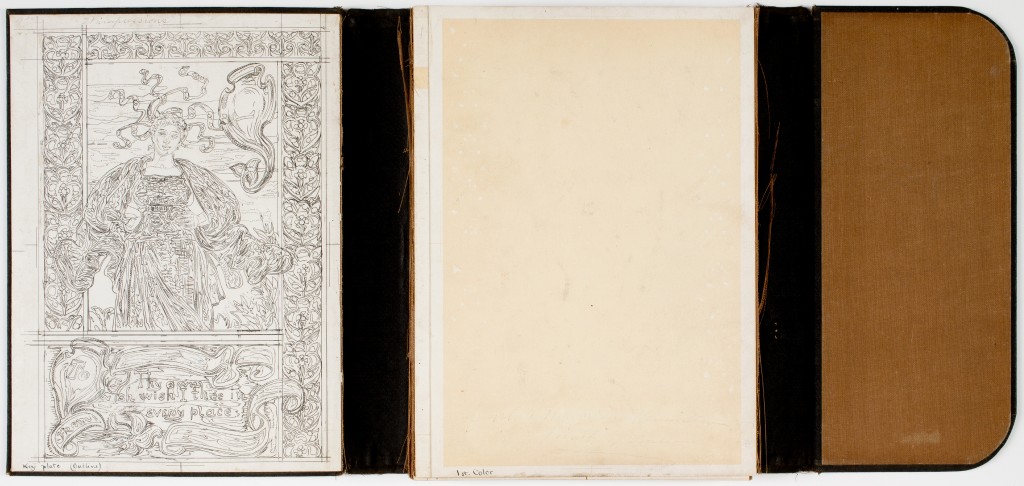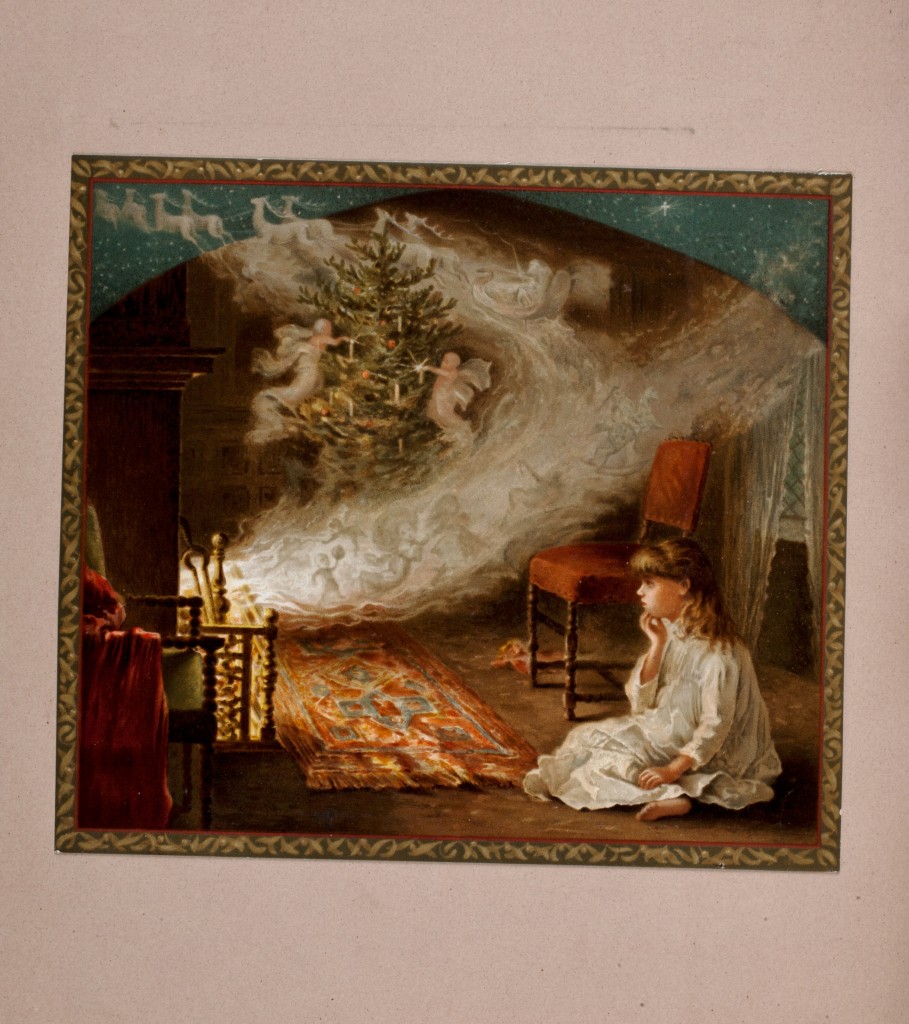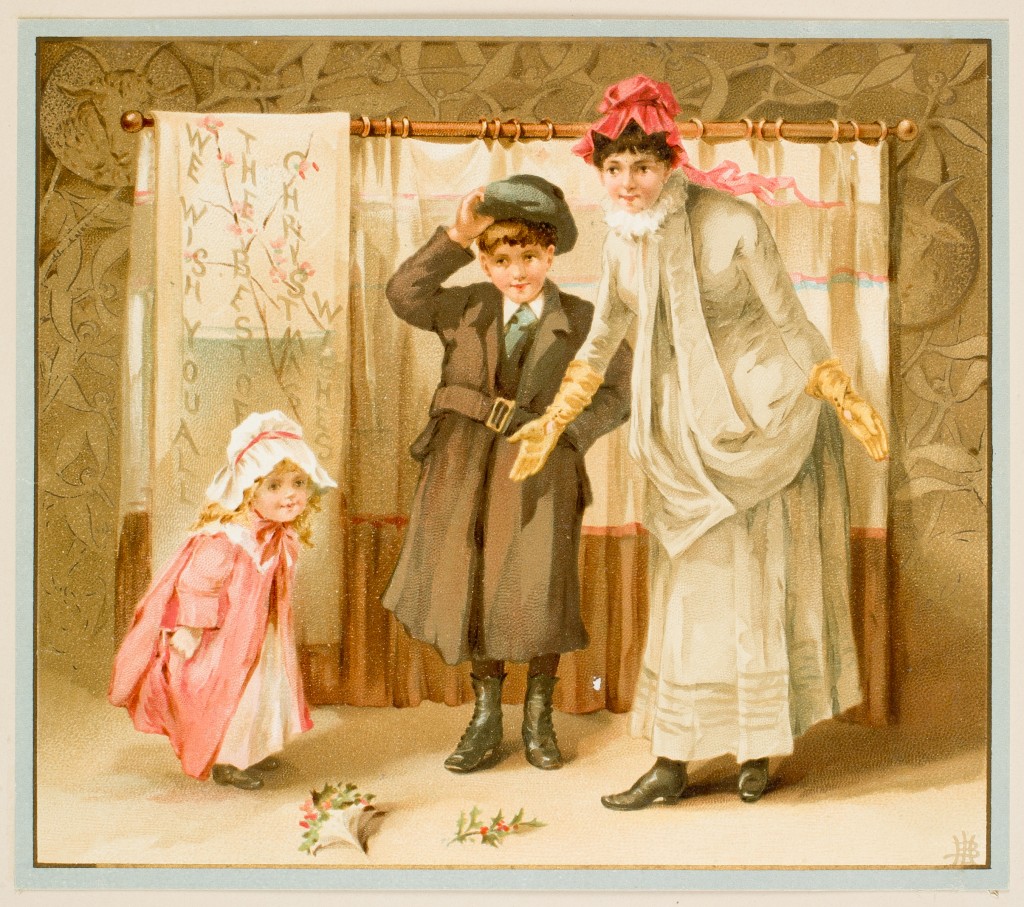S tarting in 1880, the chromolithographer Louis Prang held an annual design contest for the selection of his color-printed Christmas cards. Prang, who is often called “The Father of the American Christmas Card,” helped to popularize the practice of sending cards in the United States after he made an 1864 visit to Europe. While there he studied the latest color printing techniques in Germany, and when he returned to Boston he began printing elaborately designed, multi-colored “art cards.” Although holiday cards had been around in Europe since the 1840s, it was Prang’s efforts, starting around 1873, that really got the practice going in America.
tarting in 1880, the chromolithographer Louis Prang held an annual design contest for the selection of his color-printed Christmas cards. Prang, who is often called “The Father of the American Christmas Card,” helped to popularize the practice of sending cards in the United States after he made an 1864 visit to Europe. While there he studied the latest color printing techniques in Germany, and when he returned to Boston he began printing elaborately designed, multi-colored “art cards.” Although holiday cards had been around in Europe since the 1840s, it was Prang’s efforts, starting around 1873, that really got the practice going in America.
The design contests were a huge success and were widely commented on in the American press. There were cash prizes for the winning designs and public exhibitions of the contestants’ original works (which Prang purchased). Prang was a master marketer, soliciting designs from prominent American artists both inside the academy and out. His salesmen promoted the winning cards to retailers, advertisements were taken out in newspapers and magazines, and American customers responded with purchases. The Society’s Prang archive holds many examples of these prize-winning cards, including the printer’s progressive proof book for the 1881 1st prize winner, Elihu Vedder’s young woman with ribbons (see above right and below).
 The final Prang Christmas card contest was held in 1884, with cards produced for the 1885 season. By this point, Prang was running a giant Christmas contest publicity machine. First he announced the group of artists that he was planning to solicit for designs. There were 22 artists for the 1884 contest, including the painter Thomas Moran, printmaker Frederick Freer, and artist J. Alden Weir. There were also artists who had won previous years, or had produced other non-holiday work for Louis Prang & Co. Next, the 22 submitted designs were exhibited to the public at a gallery in New York in November of 1884 to great fanfare in the press. The judges were all well-known New York stationers and dealers in Christmas cards (a savvy move on Prang’s part to ingratiate his designs with the men who sold them). The public found this fitting. One reporter noted, “This mode of deciding a very delicate question seemed to promise by its simplicity the results to be desired, as the dealers might well be considered good representatives of the popular feeling in regard to those tokens of friendship and good-will which custom has now elevated to a recognized institution at Christmas-tide.” Selections were made and then announced by the judges. There were four cash prizes in the 1884 contest, with the first prize of
The final Prang Christmas card contest was held in 1884, with cards produced for the 1885 season. By this point, Prang was running a giant Christmas contest publicity machine. First he announced the group of artists that he was planning to solicit for designs. There were 22 artists for the 1884 contest, including the painter Thomas Moran, printmaker Frederick Freer, and artist J. Alden Weir. There were also artists who had won previous years, or had produced other non-holiday work for Louis Prang & Co. Next, the 22 submitted designs were exhibited to the public at a gallery in New York in November of 1884 to great fanfare in the press. The judges were all well-known New York stationers and dealers in Christmas cards (a savvy move on Prang’s part to ingratiate his designs with the men who sold them). The public found this fitting. One reporter noted, “This mode of deciding a very delicate question seemed to promise by its simplicity the results to be desired, as the dealers might well be considered good representatives of the popular feeling in regard to those tokens of friendship and good-will which custom has now elevated to a recognized institution at Christmas-tide.” Selections were made and then announced by the judges. There were four cash prizes in the 1884 contest, with the first prize of $1,000 going to Ohio artist C. D. Weldon for his image of a young girl dreaming in front of a fireplace left).
$1,000 going to Ohio artist C. D. Weldon for his image of a young girl dreaming in front of a fireplace left).
But wait, Prang was not done yet! The 22 paintings were then packed up and shipped to Boston, with the four winners and all the others prominently featured at the gallery of Noyes & Blakeslee on Tremont Street for the 1884 Christmas holiday. At this point, Prang opened it up to the public, allowing Boston residents to vote on another winner, creating what became known as “The Boston Card.” The top four remained in place, but visitors to the gallery were encouraged to vote for their favorite from the remaining 18 paintings. In the 1884 contest, that honor went to Miss Lizbeth B. Humphrey’s design showing three children taking bows before a homemade curtain (see below).
Humphrey was born in 1841 in Millbury, Massachusetts. In 1849, when she was eight years old, her parents moved to the Hopedale Community, a religion-based utopian compound founded by Adin Ballou in 1842. According to Ballou, Hopedale stood for “temperance, abolitionism, woman’s rights, spiritualism and education.” Although the community disbanded before 1860, Lizbeth Humphrey spent most of her childhood living communally in Worcester County. After the Civil War, she became a very successful illustrator, creating images for children’s books and for the illustrated press. She won second and third prize in the 1881 Prang Christmas card contest and her work was well known to Bostonians.
The Boston Card win stands out among the other Prang prize card designs, however, mainly because of its modern tone. Most of the winning cards show snowy landscapes, idealized children, magical scenes, nativities, and angels. This card is different. There is a narrative that has to be filled in by the viewer, who would immediately recognize the scene, often played out in middle class parlors, of children “putting on a show” (a recent blog post talks about one such play put on in a Boston parlor on Thanksgiving in 1875). One reviewer wrote, “The design is illustrative entirely of the modern Christmas. …While all the figures are admirable drawn, the [smallest] child in pose, coloring, and expression deserves to be recognized as, it were aptly called, an idyllic inspiration. Every spectator is delighted with it, from whatever point of view it is regarded, as a poem of childhood or as a gem of art.” Humphrey used real children as her models, drawing on kids in her Milford neighborhood as Norman Rockwell would do a generation later. The three children on The Boston Card have been identified as Arthur Draper, Marjorie Humphrey (the artist’s adopted younger sister) and Annie Knight. They take their bows in front of a homemade curtain and banner, with a bouquet and a sprig of holly at their feet.
show snowy landscapes, idealized children, magical scenes, nativities, and angels. This card is different. There is a narrative that has to be filled in by the viewer, who would immediately recognize the scene, often played out in middle class parlors, of children “putting on a show” (a recent blog post talks about one such play put on in a Boston parlor on Thanksgiving in 1875). One reviewer wrote, “The design is illustrative entirely of the modern Christmas. …While all the figures are admirable drawn, the [smallest] child in pose, coloring, and expression deserves to be recognized as, it were aptly called, an idyllic inspiration. Every spectator is delighted with it, from whatever point of view it is regarded, as a poem of childhood or as a gem of art.” Humphrey used real children as her models, drawing on kids in her Milford neighborhood as Norman Rockwell would do a generation later. The three children on The Boston Card have been identified as Arthur Draper, Marjorie Humphrey (the artist’s adopted younger sister) and Annie Knight. They take their bows in front of a homemade curtain and banner, with a bouquet and a sprig of holly at their feet.
Humphrey continued to design for Prang, creating birthday and Easter cards, prints and other colorful images, usually of modern children, until at least 1898, but 1884 was the final season of the holiday card contest at Prang’s. By 1890, Prang stopped producing cards as the flood of inexpensive colored cards coming from Europe and other American printers was too great to overcome, even with clever contests and press attention. Nonetheless, we can largely thank Prang for creating a strong tradition that has managed to survive even today’s electronic-centered world!

One thought on “The People’s Choice: Prang Christmas Card Contests”